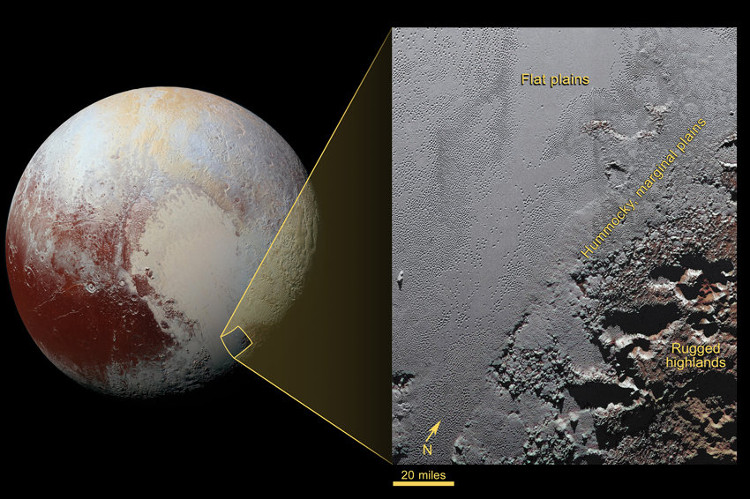Spot the black plateau on Pluto
Through an enlarged image taken from NASA's New Horizons spacecraft, scientists found southeastern Pluto's plains adjacent to the black plateau separated by rugged, rugged terrain. .
The plateau is officially named Krun Macula ( "Krun" after the lord of the ancient religious world of Mandaean; "Macula " means the black stain on the face of Pluto, which is dark red, due to the distribution of p -hydrocarbon particles called tholins on the surface).

Photo taken from the New Horizons spacecraft.
Macula Krun is 2.5 km higher than the big plain called Sputnik Planum and is not seamless due to cluster formation, forming giant pits with a diameter of 8 - 13 km, depths of up to 2.5 km.
The black and plain plateau is separated by dense pits that form a slot longer than 40 km, 12.5 km wide and nearly 3 km deep - nearly twice the Grand Canyon in Arizona - and covered with nitrogen ice. Scientists identify deep holes that can form through surface collapse, but cannot explain the cause of the collapse.
This image was obtained through three separate observations from New Horizons in July 2015.
The right half of the picture was taken from a distance of 15,850km, while the left half of the picture was 24,900km from Pluto by the Long Range Reconnaissance Imager telescope (LORRI) . Color data taken at an altitude of 33,900km through a multi-spectral camera Ralph / Multispectral Visible Imaging Camera (MVIC) .
- Three Sunspots viewed from Earth
- A black spot 800,000 km long on the Sun was discovered
- Marvel at the substance found under Pluto
- Discover the mysterious ice lake on Pluto
- NASA continues to publish more new photos of Pluto
- The sun flare broke out, heading towards Earth
- Vulcan leads the poll of the name of the Pluto moon
- NASA announces the latest proof of life on Pluto?
- What is mysterious about Pluto's atmosphere?
- Deep sea can be found on Pluto
- Video: Skyscraper-like high mountain reveals the past of Pluto
- Unexpected discovery: Pluto is capable of emitting X-rays
 Van Allen's belt and evidence that the Apollo 11 mission to the Moon was myth
Van Allen's belt and evidence that the Apollo 11 mission to the Moon was myth The levels of civilization in the universe (Kardashev scale)
The levels of civilization in the universe (Kardashev scale) Today Mars, the sun and the Earth are aligned
Today Mars, the sun and the Earth are aligned The Amazon owner announced a secret plan to build a space base for thousands of people
The Amazon owner announced a secret plan to build a space base for thousands of people